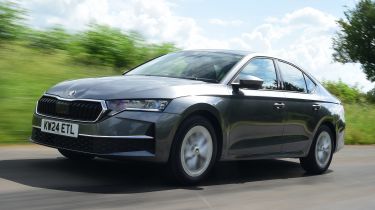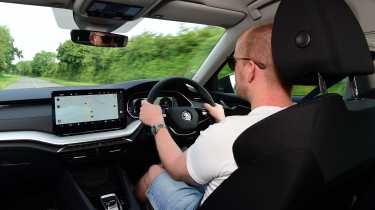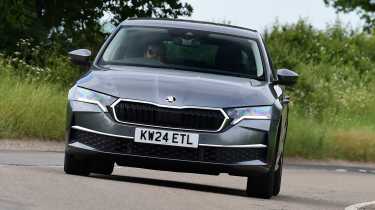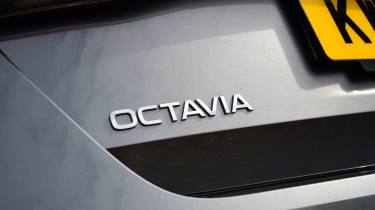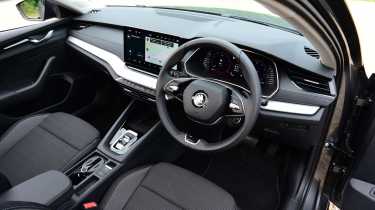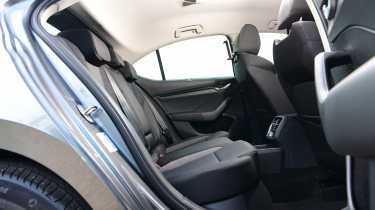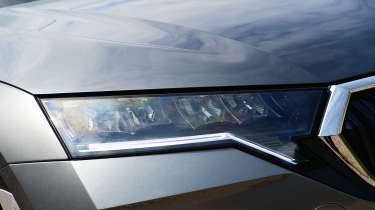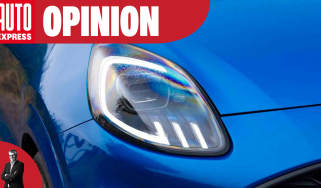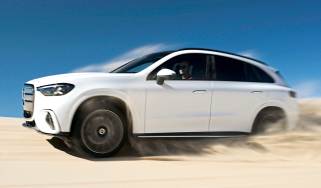Skoda Octavia review
Considering its budget roots, the Skoda Octavia feels surprisingly upmarket, yet it’s still practical and spacious

Our opinion on the Skoda Octavia
A mid-life update for the Skoda Octavia tweaked the looks, but nothing much changed in terms of whether you should buy one; if you need a hugely practical family car that’s comfortable, refined, good to drive and well-equipped, then the Octavia should be at the top of your shopping list.
The Octavia is available in hatchback and truly cavernous estate forms, and it’s the former that we’re focusing on here. It’s Skoda’s biggest-selling car – more than seven million units have been shifted in the Octavia’s 28-year lifetime – and it has now reached the midway point of its fourth generation.
About the Skoda Octavia
In some ways, the Skoda Octavia has transformed significantly over the years, but in the key areas where it excels – comfort, practicality and value for money – it hasn’t. The fourth generation arrived in 2020 and was given a handful of styling changes and a revised engine range in 2024. However, it remains as a high-quality family car with the same vast amount of space it's always had.
The current Octavia has won multiple Auto Express New Car Awards over the years. In fact, it’s our reigning Family Car of the Year. The facelift arrived while the car was already at the top of its game, so the revisions – a refreshed look and updated tech – didn’t need to be major to keep it competitive.
Used - available now

2020 Skoda
Octavia
19,383 milesManualPetrol1.5L
Cash £15,700
2017 Skoda
Octavia
70,189 milesManualPetrol2.0L
Cash £12,495
2024 Skoda
Octavia
19,589 milesAutomaticDiesel2.0L
Cash £22,549
2018 Skoda
Octavia
50,983 milesAutomaticPetrol1.4L
Cash £10,275The most notable tweak to the range was the arrival of a ‘low-power’ 1.5 TSI petrol engine. This replaced the previous 1.0 TSI three-cylinder, and is the same four-cylinder motor that’s found elsewhere in the range, but it has been detuned to make 114bhp (5bhp more than the 1.0 TSI) and 220Nm of torque. The result is a smoother and more responsive unit that offers similar fuel economy. The more powerful version of this engine has 148bhp and 250Nm of torque.
Both engines come with the option of a six-speed manual or a seven-speed DSG automatic gearboxes, with the latter featuring mild-hybrid tech to keep emissions down. There’s also a 2.0-litre diesel with 114bhp in manual form and 148bhp in automatic form, though the diesel auto doesn’t come with the mild hybrid set-up.
We’ve tested the Skoda Octavia on a wide variety of UK roads. In fact, we’ve been so impressed with its performance as a family car that it even managed to beat its sibling, the Volkswagen Golf, in our twin test. We also had a pre-facelift example of the Skoda Octavia Estate on our long-term test fleet for six months in order to find out exactly what the car is like to live with day-to-day.
This review focuses on the Octavia hatchback, but we also have a dedicated in-depth review of the Skoda Octavia Estate if you fancy something even more practical.
Skoda Octavia prices and latest deals
Skoda has trimmed the Octavia’s trim level selection down slightly since launch. Today, the line-up starts off with the entry-level SE Technology from £28,500. In the middle of the range reside the SE L and SportLine, which start from £33,000 and £34,100, respectively. At the very top sits the performance-focused Octavia vRS, which commands at least £40,600.
If you want to save an average of up to £2,800, you can build your perfect, brand-new Skoda Octavia via the Auto Express Buy a Car service. We also have a number of new Octavias in stock, along with plenty of used Skoda Octavia deals. You can also sell your old car with us.
Performance & driving experience
Pros |
|
Cons |
|
Under the skin, the Skoda Octavia sports an engine line-up that shares much with other VW Group stablemates.
The range kicks off with a 1.5 TSI petrol producing a grunty 220Nm of torque, which means that it feels more lively than its 114bhp would have you believe. Above this sits a 148bhp version of the same 1.5 TSI unit, adding a further 30Nm of torque to boost in-gear flexibility.
These engines also dictate the trim level you must have, because the less potent version is only offered with the entry-level SE Technology, while the more powerful choice becomes available in SE L and SportLine trims. Automatic versions get mild-hybrid tech to improve fuel economy by as much as 4mpg over the manual gearbox option that goes without.
Diesel choices come in the form of a pair of 2.0-litre turbocharged units that produce either 114bhp and 300Nm or 148bhp and 360Nm. The latter makes that peak torque figure from just 1,600rpm, offering excellent real-world pulling power. In this instance, the lower-powered unit has a six-speed manual transmission, while the latter is equipped with a DSG automatic.
At the top of the Octavia range sits the hotter vRS. In its latest incarnation, this version is more powerful than ever before, producing 262bhp from its turbocharged four-cylinder EA888 petrol engine. Peak torque is 370Nm, all of which is sent to the front wheels via a seven-speed DSG gearbox.
| Model | Power | 0-62mph | Top speed |
| Octavia 1.5 TSI SE Technology | 114bhp | 10.4 seconds | 126mph |
| Octavia 1.5 150 TSI SE L | 148bhp | 8.5 seconds | 142mph |
| Octavia 2.0 TDI 150 SE Technology | 148bhp | 8.5 seconds | 141mph |
Performance, 0-60mph acceleration and top speed
The entry-level 1.5-litre TSI petrol has a 0-62mph time of 10.4 seconds and a top speed of 126mph, while the 148bhp version of this engine cuts the 0 to 62mph time to 8.5 seconds, and the top speed increases to 142mph.
The 114bhp/300Nm diesel, meanwhile, manages 0-62mph in 10.4 seconds, while the more powerful 148bhp/360Nm variant does the same in 8.5 seconds. The top speed of the former is 132mph, while the latter manages 141mph.
The sporty Octavia vRS is the quickest from 0-62mph, with this 261bhp model capable of 0-62mph in 6.4 seconds. It’ll then proceed to an electronically limited top speed of 155mph.
Town driving, visibility and parking
The Octavia is a big car for the class at almost 4.7 metres long, and most of that extra bodywork is hanging out the back, which means positioning the rear in a tight parking space requires a touch more care than in some rivals. Fortunately, front and rear parking sensors are fitted on all trim levels. Meanwhile, the Skoda’s steering is light, as is the clutch pedal for the slick manual gearshift. The automatic gearbox can be a little jerky when moving off, however.
Country road driving and handling
On the move, comfort is the name of the game for this Czech hatchback. There’s not much driver involvement to be found because the steering doesn’t offer much feedback, and the chassis feels a little nose-heavy. A soft suspension set-up delivers great ride comfort.
The Skoda’s suspension is among the most supple examples in the segment, and relaxed damping means the car tends to float across bumps rather than thump into them. It’s at its most relaxing in base models, where modestly sized 16-inch alloy wheels and a generous tyre sidewall help to soak up most imperfections in the road. The sporty vRS gets a unique chassis tune, which makes it much more engaging through the turns.
Sporty vRS aside, straight-line performance isn’t outstanding, but the engine line-up scores well for overall refinement, and the petrol and diesel variants all deliver smooth, consistent power.
Motorway driving and long-distance comfort
The Skoda’s engine traits work well at high speeds, where their low-down responsiveness means that the gearbox doesn’t need to be worked too hard to maintain speed up steep hills or when performing overtakes.
While straight-line stability at 70mph isn’t quite as unshakeable as a Volkswagen Golf, it’s still a superbly refined and relaxing place to be. One or two alternative models are marginally more refined, but road noise is kept fairly low in the Skoda, similar to the Golf.
“For two cars so mechanically similar, the Golf and Octavia feel quite different to drive. The Skoda’s much softer suspension means more body roll, and it takes a little longer to settle after hitting big bumps, but makes it a more comfortable cruiser.” - Alex Ingram, chief reviewer.
MPG & running costs
Pros |
|
Cons |
|
While Skoda’s badge might not have the same appeal to some, you’re getting a physically larger car for less money than the equivalent Golf, so that seems like strong value.
It’s a shame that diesel has been so demonised in recent years, because the Octavia proves a modern diesel can still return mpg figures that even the most efficient petrols (or electrically assisted PHEVs) will struggle to match, especially on a long motorway run where the Octavia diesel will easily surpass 60mpg on the WLTP combined cycle. That means it’s possible to top 500 miles on longer journeys despite a fairly modest 45-litre fuel tank.
That’s not to say the petrol models aren’t impressive, though, as you can still expect fuel economy of 50-plus mpg on a similar journey. Engines equipped with mild-hybrid tech cut the power for short periods and when coasting to minimise unnecessary petrol usage.
The Octavia vRS focuses more on performance than economy, but official figures in the 40mpg range are still pretty impressive for a model that’s not designed to be frugal.
| Model | MPG | CO2 | Insurance group |
| Octavia 1.5 TSI e-TEC SE Technology | 57.3mpg | 112g/km | 14 |
| Octavia 2.0 TSI vRS | 40.8mpg | 158g/km | 27 |
| Octavia 2.0 TDI SE Technology | 66.2mpg | 112g/km | 17 |
Insurance groups
Depending on which Octavia you choose, its insurance groups range between 14 for the 1.5-litre TSI SE Technology and 22 for the 2.0-litre TDI, all of which are roughly standard for this category of car. The powerful vRS model has a higher rating of 27. The closely related Volkswagen Golf sits between groups 17 and 33, although the pricier coverage applies to more powerful models like the fiery Golf R.
Tax
Because there isn't a plug-in hybrid Octavia iV of this facelifted generation, this Skoda won’t be as great a choice for company car drivers as the plug-in versions of Peugeot 308 and Vauxhall Astra. That being said, for the biggest Benefit-in-Kind (BiK) company car tax savings, you’ll want to look towards fully electric cars like the Peugeot E-308 and Vauxhall Astra Electric.
Every Skoda Octavia is liable for the standard rate of VED road tax, but the vRS pushes past the £40,000 luxury car tax threshold. Opting for too many options on the Sportline will also risk incurring this yearly £620 surcharge.
Depreciation
Our expert data shows that the Skoda Octavia hatchback is expected to retain 41 to 45 per cent of its initial value after three years or 36,000 miles, depending on your chosen powertrain and trim level. It’s the same story for the estate car, too.
The Volkswagen Golf doesn’t exactly stand out in this regard, either, as it only manages 38 to 46 per cent. However, depreciation bites the Vauxhall Astra even harder as this Octavia rival only holds on to 35 to 41 per cent.
To get an accurate valuation for a specific model, check out our free car valuation tool...
Interior, design & technology
Pros |
|
Cons |
|
Following a mid-life facelift, the Skoda Octavia features revised daytime running lights, a sharper looking front bumper, fresh tail lights with animations, and some new alloy wheel designs and colour options to choose from.
The facelift also saw some trim level and engine changes. The base model is now SE Technology, which has 16-inch alloys – great for a cosseting ride – LED headlights, umbrellas in the front doors, a 10.25-inch digital instrument cluster, a 13-inch touchscreen with Android Auto and Apple CarPlay, wireless phone charging, dual-zone air-con, keyless start, and heated front seats. This is a good level of kit for the money, and the umbrellas are a unique Skoda touch that’s also found on a Rolls-Royce.
Interior and dashboard design
The fourth-generation Skoda Octavia took a noticeable leap forward in design over its predecessor when it was released, with the old car’s worthy but slightly dull design replaced with something much more contemporary.
The horizontal dashboard arrangement does away with its predecessor’s monolithic central dashboard layout. The latest dash is now dominated by a large touchscreen display, with a few key shortcut buttons, such as shortcuts to the climate-control menu and driver-assist functions, located below the infotainment screen.
Unfortunately, this means that the climate controls are primarily operated through the touchscreen. While it’s a logical set-up for its type, we’d still prefer to have physical buttons to work these functions.
Materials and build quality
The knurled thumbwheels on the two-spoke steering wheel, the slender chrome-finished door handles, and the soft materials that cover the dashboard all add up to make the Octavia’s understated and neatly laid-out cabin feel a cut above almost anything else in the class.
It’s got the edge over the Volkswagen Golf, with only one or two alternatives, such as the Peugeot 308, able to deliver a similar sense of occasion. The buttons on the dashboard are well damped, and the overall architecture looks and feels sturdy. Even the font on the digital driver’s display has an understated charm about it.
Infotainment, sat-nav and stereo
All versions of the facelifted Skoda Octavia have a 13-inch touchscreen. This is very similar to the system fitted to the VW Golf, but it comes with unique Skoda graphics and colours.
Over-the-air updates keep the infotainment system up to date with the latest navigation and traffic data for the standard sat-nav system, and also allows Skoda to introduce firmware revisions. The screen responds quickly to touches, and its interface is largely straightforward and easy to work out. Also included is wireless Android Auto and Apple CarPlay, and a standard wireless charging pad.
There’s no volume knob, with a slider function located beneath the screen allowing you to adjust the level. This works well enough as you can tap the slider to a point for your desired volume. However, we’re still yet to be convinced that this is a better set-up than traditional switches, buttons and knobs.
There are also no physical climate dials, with the dual-zone temperature controls integrated into the bottom of the touchscreen. There are pre-set climate-controlled commands to warm your feet or cool your face, but you can also set everything up as desired in a dedicated climate settings menu on the screen. Overall, having some of the climate controls on permanent display at the bottom of the screen is a positive step, but we’d prefer the smart dials that feature on the Skoda Superb and Skoda Kodiaq.
“The Octavia has traditionally been the more pragmatic family car choice, but this model has plenty of premium design touches inside, too.” - Alex Ingram, chief reviewer.
Boot space & practicality
Pros |
|
Cons |
|
The Skoda Octavia has long been regarded as one of the more practical cars in its class, and the latest iteration is still extremely roomy, even if there are some similarly sized electric cars and SUVs that offer comparable or better rear-seat accommodation. Factor in the Octavia’s gigantic boot, and few other models at this price point can compete with the space this Skoda offers.
No new Skoda would be complete without a range of the brand’s ‘Simply Clever’ items. Some familiar features have been updated; the umbrella mounted in the driver’s door and the ice scraper/tyre-tread depth gauge stored in the fuel filler flap are now made from more sustainable materials. Other features include a ticket holder on the driver’s side A-pillar and a handy AdBlue nozzle for diesel-powered cars, all of which make life just that bit easier.
A new addition is the optional storage box; it comes as part of the Family Package on SE L models and above. It brings a small storage area that sits between the centre console and the rear-seat bench.
There’s plenty of storage in the cabin without this, though, with the individual door bins capable of holding a 1.5-litre drinks bottle and the front central ‘jumbo box’ also available for keeping assorted items.
There are five USB-C ports in the Octavia – two in the centre console, two in the rear, and a final charging port in the rear-view mirror for those who want to hook up a dash cam.
Dimensions and size
The fourth-generation Octavia has a larger footprint than the previous model, and the facelift hasn’t changed this, with the hatchback being 19mm longer and the estate growing 22mm in length when compared with the Mk3. Both cars are 15mm wider, too.
The overall dimensions for the Octavia hatch are 4,698mm (length), 1,829mm (width, excluding mirrors), and 1,477mm (height). In comparison, the Volkswagen Golf is smaller at 4,284mm long and 1,789mm wide (excluding mirrors), although it stands a touch taller at 1,491mm.
| Dimensions comparison | |||
|---|---|---|---|
| Model | Skoda Octavia | Volkswagen Golf | Vauxhall Astra |
| Length | 4,698mm | 4,284mm | 4,374mm |
| Width | 1,829mm | 1,789mm | 1,860mm |
| Height | 1,477mm | 1,491mm | 1,441mm |
| Wheelbase | 2,690mm | 2,630mm | 2,680mm |
| Boot space | 600 to 1,700 litres | 381 to 1,237 litres | 352 to 1,339 litres |
Seats & passenger space
The driver’s seat and steering wheel feature a wide range of adjustments, making it easy for a huge variety of body types to get comfortable. Also helping on the comfort front are the seats themselves; they’re approved by the independent German organisation AGR, which promotes back health.
A deep cubby beneath the centre armrest, huge door bins and a pair of cup-holders hidden beneath a sliding cover all contribute to a driver’s environment loaded with useful storage spaces.
Rear kneeroom is fairly impressive by the standard of this class, rivalling even some taller SUV-based family models such as the Nissan Qashqai, if not delivering quite as much as the likes of the Volkswagen ID.3, whose dedicated electric platform has created more space for people on a smaller footprint.
The centre seat is wide and soft, but taller passengers on each side will find that the way the roofline curves inwards at the sides compromises headroom ever so slightly.
Boot space
At 600 litres, the Octavia has the largest boot in its class by some margin. But the load bay isn’t just big, it has some useful features, too. Beyond a couple of bag hooks, there are also levers in the luggage area so that the rear seats can be easily folded down.
Unlike some rivals, including the VW Golf, the Octavia hatchback doesn’t have a split-level load floor like you’ll find in some versions of the estate, which means that when those back seats are dropped, there’s quite a significant step left in the boot. Still, the Octavia offers a gigantic 1,555 litres of luggage space.
Another small gripe is that the load lip is quite high when compared with some rivals. So even though there’s lots of space, getting the items on board is more awkward than it could be. The Skoda Octavia Estate addresses this with a variable height boot floor in SE L trim and above, which removes the awkward loading lip. It also boasts a huge 640 litre load capacity with all five seats in place, and 1,700 litres of cargo space when you fold the rear seats down.
Towing
The Octavia’s practical appeal continues with its decent towing capability. The entry-level 1.5 TSI has a braked trailer towing capacity of 1,300kg, while the more powerful 1.5 TSI 150 and the vRS have a maximum towing weight of 1,500kg. The 2.0 TDI 150 has the greatest towing capacity in the range of 1,600kg.
“There’s only one winner in the space race: the Octavia is huge inside. Granted, it’s 416mm longer than the Golf, but it makes the most of that extra length, especially the further back you go.” - Alex Ingram, chief reviewer.
Reliability & safety
Pros |
|
Cons |
|
The Skoda Octavia didn’t feature in our latest Driver Power customer satisfaction survey, but Skoda as a brand hasn’t massively wowed its customers according to the best manufacturer rankings, landing a middling 12th place out of 31 entrants.
Euro NCAP tested the Octavia in 2022 and awarded the family hatchback its maximum five-star crash safety rating. The Octavia received strong scores of 89 and 84 per cent for adult and child passenger protection, respectively.
The Octavia offers good levels of safety kit, with top-of-the-range cars featuring front and rear parking sensors, adaptive cruise control, blind-spot detection and a head-up display. Optional safety technology on lesser models includes the Assisted Drive Package Plus, which adds blind-spot detection, park assist and speed assist.
| Euro NCAP safety ratings | |
| Euro NCAP safety rating | Five stars (2022) |
| Adult occupant protection | 89% |
| Child occupant protection | 84% |
| Vulnerable road user protection | 68% |
| Safety assist | 81% |
Buying and owning
- Best buy: Skoda Octavia 1.5 150PS DSG SE Technology
The Skoda Octavia 1.5 150PS DSG SE Technology is our pick of the range. Despite being at the lower end of the trim range, it has all the kit you should realistically need, and the 148bhp engine is strong yet economical. Both the hatchback and estate offer plenty of practicality, so your chosen body type will boil down mostly to personal preference.
Skoda Octavia alternatives
The Skoda Octavia shares its mechanical underpinnings, engines, and elements of on-board tech with the Volkswagen Golf, while there’s also the SEAT Leon rival within the Volkswagen Group family.
Competition from further afield includes cars such as the Honda Civic, Toyota Corolla and Mazda 3, but the family hatch opposition doesn’t stop there, because prospective buyers in this class are also likely to be considering the Hyundai i30, Peugeot 308 and Vauxhall Astra. What the Octavia offers over all of its rivals, though, is greater boot space, courtesy of the car’s long rear end.
Frequently Asked Questions
It’s one of the best cars you can buy if you’re looking for something practical. Few family cars offer this much space, let alone combined with such a comfortable driving experience.
Deals on the Octavia and alternatives
